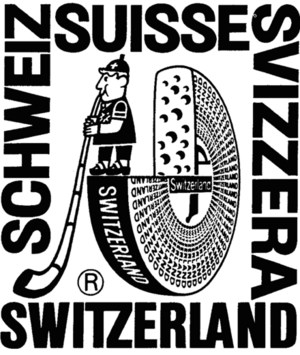Swiss Cheese Union facts for kids
The Swiss Cheese Union (also known as Schweizer Käseunion AG) was an organization in Switzerland. From 1914 to 1999, it worked like a special club to control how cheese was made and sold.
The Union made sure that only a few types of cheese were produced, mainly Gruyere and Emmental. It bought all the cheese made and then sold it. The prices were even set by the Swiss government. The Union also helped market these cheeses both in Switzerland and around the world.
A big success for the Swiss Cheese Union was helping fondue and raclette become popular national dishes in Switzerland. Before the Union's efforts, these dishes were mostly known only in certain parts of the country.
Contents
How the Swiss Cheese Union Started
Early Years (1914-1920s)
During World War I, Switzerland stayed neutral. It had a very large cheese-making industry. However, selling cheese to other countries became difficult because of the war. This problem continued even after World War II. Also, it was hard to find enough food for the dairy cows, which meant less milk and less cheese.
To help with these problems, cheese makers decided to work together. They formed a group called the Swiss Cheese Union. This group set rules to avoid competition. A journalist named Robert Smith explained that the Union decided:
- The price for milk.
- How much milk farmers should produce.
- Who farmers could sell their milk to.
- How much cheese cheesemakers should make.
- The prices for the cheese.
Because the cheese business was so complex, the Union even reduced the number of cheese types. Switzerland used to make over 1,000 different kinds of cheeses. The Cheese Union supported only seven of them.
Promoting Fondue
The Swiss Cheese Union became very good at controlling cheese production. Soon, they faced a new problem: they were making too much cheese! There was more cheese than people wanted to buy.
To solve this, the Union needed people to eat more cheese. They found a great solution: fondue. Isabelle Raboud-Schuele, a former museum director, said that before 1930, fondue was mostly known in French-speaking Switzerland. But after the Union's big campaigns in the 1930s, it became popular everywhere. It even became a national dish!
The Swiss Cheese Union promoted fondue as a special dish from the mountains. However, it actually came from small towns. The Union used famous Swiss images, like Heidi, to make fondue seem traditional and healthy. They even made posters showing rain or snow as "fondue weather." This made people feel warm and cozy when they ate it. The Union also shared recipes for making fondue for many people. This encouraged everyone to eat lots of cheese.
A Rebel Cheesemaker
Not everyone agreed with the strict rules of the Swiss Cheese Union. A cheesemaker named Sepp Barmettler wanted to make a Parmesan-like cheese called Sbrinz. He tried for eight years to get the Union to allow it. But his request was denied. The Union told him he "did not fit into the envisaged structures."
Even so, Sepp Barmettler kept making small, soft cheeses called stanser fladen. He sold them directly to small businesses like hotels and restaurants. This way, he avoided the big distributors that the Union watched closely. After the Union ended, many new Swiss cheeses appeared. Some were old recipes brought back, and others were new kinds that people like Sepp had helped keep alive.
The End of the Union
Over time, Switzerland became known more for science and engineering than for dairy farming. People started to worry about how much taxpayer money was going into the dairy industry. In the 1960s and 1970s, the dairy industry reportedly cost the Swiss government more than the entire Swiss army!
The Swiss Cheese Union even sponsored the 1992-1993 Swiss National Ski Team. The skiers wore yellow suits that looked like they had cheese holes!
In the late 1990s, there were problems with how some Union officials handled money. Because of these issues, the Swiss Cheese Union was finally closed down. The government still helped dairy farmers, but cheese makers could now compete with each other. This made cheese prices go down.
Images for kids




